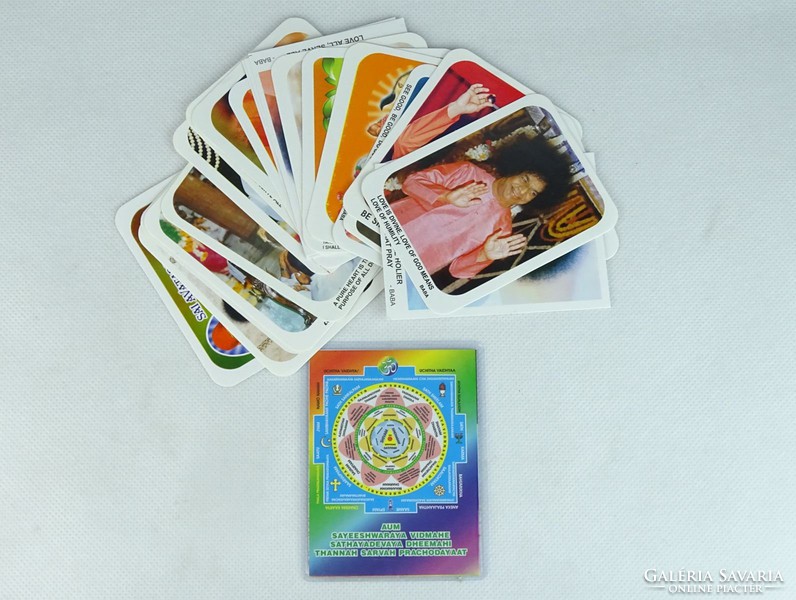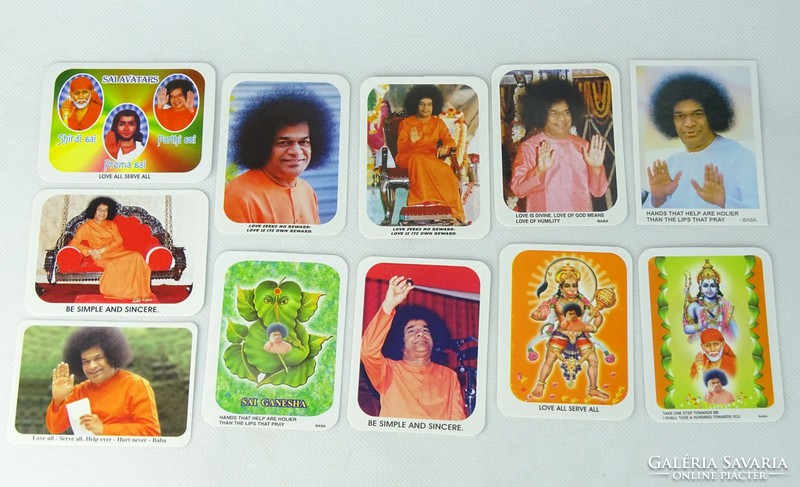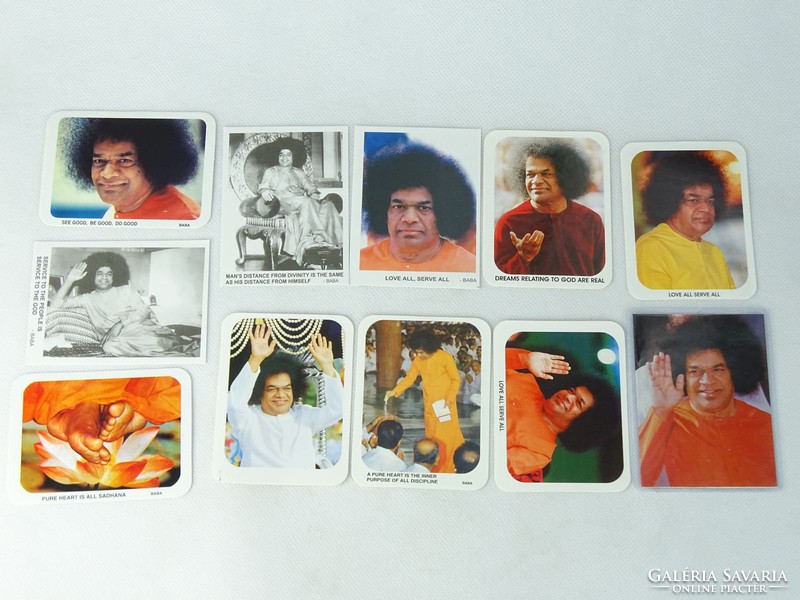0K309 Sri Sathya Sai Baba naptár 22 darab
| Feltöltés ideje: 2023. november 30. |
| Termékkód: 1401893 |
| Megtekintések: 202 |
| Megfigyelők: 0 |
| Ajánlatok: 0 ajánlat |
retrozoli (1997)
![]() BUDAPEST
BUDAPEST
Hitelesített felhasználó
Tudja meg, milyen lépésekkel tesszük biztonságosabbá és kényelmesebbé online piacterünk használatát. Részletek
Szép állapotú 2005, 2006, 2007-es naptárak Sri Sathya Sai Baba képeivel.
Szélesség: 7.5 cm
Hosszúság: 10 cm
Súly: 0.036 kg
Sathya Sai Baba
From Wikipedia, the free encyclopedia
Sathya Sai Baba
Born
Sathya Narayana Raju
23 November 1926
Puttaparthi, Madras Presidency, British India
Died
24 April 2011 (aged 84)
Puttaparthi, Andhra Pradesh, India
Nationality
Indian
Founder of
Sathya Sai Organization
Philosophy
Shirdi Sai Baba movement
Quotation
Love All, Serve All
Help Ever, Hurt Never[1][2][3]
Part of a series on
Hindu philosophy
Orthodox
- Samkhya
- Yoga
- Nyaya
- Vaisheshika
- Mimamsa
Vedanta
- Advaita Vedanta
- Vishishtadvaita
- Dvaita
- Bhedabheda
- Dvaitadvaita
- Achintya Bheda Abheda
- Shuddhadvaita
Heterodox
- Charvaka
Other schools[show]
Teachers (Acharyas)[show]
Major texts[show]
- Hinduism
- Other Indian philosophies
- v
- t
- e
Sathya Sai Baba (born Sathya Narayana Raju; 23 November 1926 – 24 April 2011[4]) was an Indian guru and philanthropist.[5] He claimed to be the reincarnation of Sai Baba of Shirdi.[6]
Sai Baba's materialisations of vibhuti (holy ash) and other small objects such as rings, necklaces, and watches, along with reports of miraculous healings, resurrections, clairvoyance, bilocation, and alleged omnipotence and omniscience, were a source of both fame and controversy.[7] His devotees considered them signs of his divinity, while sceptics viewed them as simple conjuring tricks. He further faced accusations over the years of sexual abuse and fraud, which he rejected as smear campaigns.[8][9]
The Sathya Sai Organisation, founded by Sathya Sai Baba "to enable its members to undertake service activities as a means to spiritual advancement",[10] has over 1,200 Sathya Sai Centres (branches) in 126 countries.[11] Through this organisation, Sathya Sai Baba established a network of free hospitals, clinics, drinking water projects, auditoriums, ashrams and schools.[12][13][14]
Contents[hide]
- 1Life
- 1.1Early life
- 1.2Proclamation
- 1.3First mandir and development of Puttaparthi
- 1.4Stroke and paralysis
- 1.5Prediction of reincarnation
- 1.6Africa
- 1.7Later years
- 1.8Old age and illness
- 1.9Death
- 1.10Funeral and mourning
- 1.11Opening of residence
- 1.12Release of will
- 2Bibliography of works
- 3Sathya Sai Organisation
- 4Institutions, projects and other works
- 4.1Educational institutions
- 4.1.1Sri Sathya Sai Institute of Higher Learning
- 4.1.2Sri Sathya Sai Higher Secondary School
- 4.1.3Others
- 4.2Hospitals and medical care
- 4.2.1Sri Sathya Sai General Hospital, Whitefield
- 4.2.2Sri Sathya Sai Institute of Higher Medical Sciences, Puttaparthi
- 4.2.3Sri Sathya Sai Institute of Higher Medical Sciences, Whitefield
- 4.3Drinking water supply projects
- 4.3.1Anantapur
- 4.3.2Chennai
- 4.4Odisha
- 4.5Educare
- 4.6Spiritual media
- 4.1Educational institutions
- 5Recognition
- 6Ashrams and mandirs
- 6.1Prasanthi Nilayam
- 6.2Sathyam, Shivam, Sundaram
- 7Beliefs and practices of devotees
- 8Criticism
- 9Responses to criticism
- 10Notable followers
- 11References
- 12Further reading
- 13External links
Life[edit]
Early life[edit]
Almost everything known about Sathya Sai Baba's early life stems from the hagiography that grew around him, narratives that hold special meaning to his devotees and are considered by them to be evidence of his divine nature.[6][15][16] According to these sources, Sathya Narayana Raju was born to Meesaraganda Eashwaramma and Peddavenkama Raju Ratnakaram in the village of Puttaparthi, to a Raju family, in what was the Madras Presidency of British India.[6][17][18] His birth, which his mother Eashwaramma asserted was by miraculous conception, was also said to be heralded by miracles.[5][6][19]
Sai Baba's siblings included elder brother Ratnakaram Sesham Raju (1921–1984), sisters Venakamma (1923–1993) and Parvathamma (1928–1998), and younger brother Janakirammiah (1930–2003).[20]
As a child, he was described as "unusually intelligent" and charitable, though not necessarily academically inclined, as his interests were of a more spiritual nature.[6][16] He was uncommonly talented in devotional music, dance and drama.[16][21] From a young age, he was alleged to have been capable of materialising objects such as food and sweets out of thin air.[22][23]
Proclamation[edit]
Sathya Sai Baba at the age of 14, soon after proclaiming himself as the avatar of Shirdi Sai Baba
On 8 March 1940, while living with his elder brother Sesham Raju in Uravakonda, a small town near Puttaparthi, Sathya was apparently stung by a scorpion.[22][23] He lost consciousness for several hours[21] and in the next few days underwent a noticeable change in behaviour.[23] There were "symptoms of laughing and weeping, eloquence and silence."[23][24] It is claimed that then "he began to sing Sanskrit verses, a language of which he had no prior knowledge."[5] Doctors concluded his behaviour to be hysteria.[5][23] Concerned, his parents brought Sathya back home to Puttaparthi[25] and took him to many priests, doctors and exorcists. One of the exorcists at Kadiri, a town near Puttaparthi, went to the extent of torturing him with the aim of curing him;[further explanation needed] Sathya seemingly kept calm throughout, which further worried his parents.[23][24]
On 23 May 1940, Sathya called household members and reportedly materialised prasad and flowers for his family members.[26] His father became furious at seeing this, thinking his son was bewitched. He took a stick and threatened to beat him if Sathya did not reveal who he really was. On 20 October 1940, the young Sathya responded calmly and firmly "I am Sai Baba", a reference to Sai Baba of Shirdi.[5][21] This was the first time he proclaimed himself to be the reincarnation of Sai Baba of Shirdi—a saint who became famous in the late 19th and early 20th centuries in Maharashtra and had died eight years before Sathya was born.[5][25][27]
First mandir and development of Puttaparthi[edit]
In 1944, a mandir for Sathya Sai Baba's devotees was built near the village of Puttaparthi. It is now referred to as the "old mandir".[28][29] The construction of Prashanthi Nilayam, the current ashram, began in 1948 and was completed in 1950.[6][29] In 1954, Sathya Sai Baba established a small free general hospital in the village of Puttaparthi.[30] He won fame for mystical powers and the ability to heal.[31] In 1957 Sathya Sai Baba went on a North Indian temple tour.[18]
Stroke and paralysis[edit]
In 1963, Sathya Sai Baba suffered a stroke and four severe heart attacks, which left him paralysed on one side.[32] These events culminated in an event where he apparently healed himself in front of the thousands of people gathered in Prashanthi Nilayam who were then praying for his recovery.[6]
Prediction of reincarnation[edit]
On recovering, Sai Baba announced that he would one day next be reborn as an incarnation named Prema Sai Baba in the neighbouring state of Karnataka.[6] He stated, "I am Siva-Sakthi, born in the gotra (lineage) of Bharadwaja, according to a boon won by that sage from Siva and Sakthi. Siva was born in the gotra of that sage as Sai Baba of Shirdi; Siva and Sakthi have incarnated as Myself in his gotra now; Sakthi alone will incarnate as the third Sai (Prema Sai Baba) in the same gotra in Mandya district of Karnataka State."[6][33] He stated he would be born again eight years after his death at the age of 96,[34] but died at the age of 84.[35]
Africa[edit]
On 29 June 1968, Sathya Sai Baba made his only overseas trip, to Kenya and Uganda.[32][36] In Nairobi, he spoke of his personal mission:
"I have come to light the lamp of Love in your hearts, to see that it shines day by day with added lustre. I have not come on behalf of any exclusive religion. I have not come on a mission of publicity for a sect or creed or cause, nor have I come to collect followers for a doctrine. I have no plan to attract disciples or devotees into my fold or any fold. I have come to tell you of this unitary faith, this spiritual principle, this path of Love, this virtue of Love, this duty of Love, this obligation of Love."[37]
Later years[edit]
In 1968, he established Dharmakshetra or the Sathyam Mandir in Mumbai.[38] In 1973, he established the Shivam Mandir in Hyderabad.[38] On 19 January 1981, in Chennai, he inaugurated the Sundaram Mandir.[38]
Garanciális feltételek
| Garancia: 7 nap |
Fizetési opciók
| Banki előre utalás |
| Készpénz |
| Postai utánvétel |
| PayPal |
Szállítási opciók
| Szállítás innen: Magyarország Feldolgozási idő: 1-2 munkanap A feldolgozási idő megmutatja, hogy az eladónak a fizetéstől számítva mennyi időre van szüksége a tárgy becsomagolásához és feladásához. Ez alapján tájékozódhat a vevő, hogy a fizetést követően mikor várhatja a csomag feladását. | |
| Személyes átvétel | Budapest IX. |
| MPL - csomagautomata | 1650 HUF |
| MPL - házhozszállítás | 1800 HUF |
| PostaPont | 1650 HUF |




